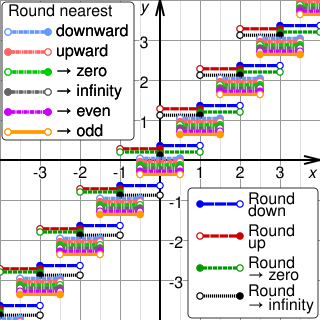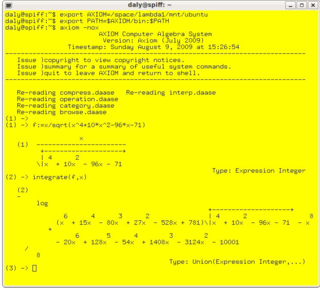In software engineering and mathematics, numerical error is the error in the numerical computations.
Contents

In software engineering and mathematics, numerical error is the error in the numerical computations.

It can be the combined effect of two kinds of error in a calculation.
Floating-point numerical error is often measured in ULP (unit in the last place).

In computing, floating-point arithmetic (FP) is arithmetic using formulaic representation of real numbers as an approximation to support a trade-off between range and precision. For this reason, floating-point computation is often used in systems with very small and very large real numbers that require fast processing times. In general, a floating-point number is represented approximately with a fixed number of significant digits and scaled using an exponent in some fixed base; the base for the scaling is normally two, ten, or sixteen. A number that can be represented exactly is of the following form:

Numerical analysis is the study of algorithms that use numerical approximation for the problems of mathematical analysis. Numerical analysis naturally finds application in all fields of engineering and the physical sciences, but in the 21st century also the life sciences, social sciences, medicine, business and even the arts have adopted elements of scientific computations. The growth in computing power has revolutionized the use of realistic mathematical models in science and engineering, and subtle numerical analysis is required to implement these detailed models of the world. For example, ordinary differential equations appear in celestial mechanics ; numerical linear algebra is important for data analysis; stochastic differential equations and Markov chains are essential in simulating living cells for medicine and biology.
A computer algebra system (CAS) or symbolic algebra system (SAS) is any mathematical software with the ability to manipulate mathematical expressions in a way similar to the traditional manual computations of mathematicians and scientists. The development of the computer algebra systems in the second half of the 20th century is part of the discipline of "computer algebra" or "symbolic computation", which has spurred work in algorithms over mathematical objects such as polynomials.

Rounding means replacing a number with an approximate value that has a shorter, simpler, or more explicit representation. For example, replacing $23.4476 with $23.45, the fraction 312/937 with 1/3, or the expression √2 with 1.414.
In the mathematical subfield of numerical analysis, numerical stability is a generally desirable property of numerical algorithms. The precise definition of stability depends on the context. One is numerical linear algebra and the other is algorithms for solving ordinary and partial differential equations by discrete approximation.

Theoretical computer science (TCS) is a subset of general computer science that focuses on mathematical aspects of computer science such as the theory of computation, lambda calculus, and type theory.
In numerical analysis, the Kahan summation algorithm, also known as compensated summation, significantly reduces the numerical error in the total obtained by adding a sequence of finite-precision floating-point numbers, compared to the obvious approach. This is done by keeping a separate running compensation.
A roundoff error, also called rounding error, is the difference between the result produced by a given algorithm using exact arithmetic and the result produced by the same algorithm using finite-precision, rounded arithmetic. Rounding errors are due to inexactness in the representation of real numbers and the arithmetic operations done with them. This is a form of quantization error. When using approximation equations or algorithms, especially when using finitely many digits to represent real numbers, one of the goals of numerical analysis is to estimate computation errors. Computation errors, also called numerical errors, include both truncation errors and roundoff errors.
In computer science, the precision of a numerical quantity is a measure of the detail in which the quantity is expressed. This is usually measured in bits, but sometimes in decimal digits. It is related to precision in mathematics, which describes the number of digits that are used to express a value.

Mesh generation is the practice of creating a mesh, a subdivision of a continuous geometric space into discrete geometric and topological cells. Often these cells form a simplicial complex. Usually the cells partition the geometric input domain. Mesh cells are used as discrete local approximations of the larger domain. Meshes are created by computer algorithms, often with human guidance through a GUI, depending on the complexity of the domain and the type of mesh desired. The goal is to create a mesh that accurately captures the input domain geometry, with high-quality (well-shaped) cells, and without so many cells as to make subsequent calculations intractable. The mesh should also be fine in areas that are important for the subsequent calculations.
Computational mechanics is the discipline concerned with the use of computational methods to study phenomena governed by the principles of mechanics. Before the emergence of computational science as a "third way" besides theoretical and experimental sciences, computational mechanics was widely considered to be a sub-discipline of applied mechanics. It is now considered to be a sub-discipline within computational science.
Numerical linear algebra, sometimes called applied linear algebra, is the study of how matrix operations can be used to create computer algorithms which efficiently and accurately provide approximate answers to questions in continuous mathematics. It is a subfield of numerical analysis, and a type of linear algebra. Computers use floating-point arithmetic and cannot exactly represent irrational data, so when a computer algorithm is applied to a matrix of data, it can sometimes increase the difference between a number stored in the computer and the true number that it is an approximation of. Numerical linear algebra uses properties of vectors and matrices to develop computer algorithms that minimize the error introduced by the computer, and is also concerned with ensuring that the algorithm is as efficient as possible.

Computational mathematics involves mathematical research in mathematics as well as in areas of science where computing plays a central and essential role, and emphasizes algorithms, numerical methods, and symbolic computations.
The Library of Efficient Data types and Algorithms (LEDA) is a proprietarily-licensed software library providing C++ implementations of a broad variety of algorithms for graph theory and computational geometry. It was originally developed by the Max Planck Institute for Informatics Saarbrücken. Since 2001, LEDA is further developed and distributed by the Algorithmic Solutions Software GmbH.
Iterative refinement is an iterative method proposed by James H. Wilkinson to improve the accuracy of numerical solutions to systems of linear equations.

In mathematics and computer science, computer algebra, also called symbolic computation or algebraic computation, is a scientific area that refers to the study and development of algorithms and software for manipulating mathematical expressions and other mathematical objects. Although computer algebra could be considered a subfield of scientific computing, they are generally considered as distinct fields because scientific computing is usually based on numerical computation with approximate floating point numbers, while symbolic computation emphasizes exact computation with expressions containing variables that have no given value and are manipulated as symbols.
In mathematics, specifically in computational geometry, geometric nonrobustness is a problem wherein branching decisions in computational geometry algorithms are based on approximate numerical computations, leading to various forms of unreliability including ill-formed output and software failure through crashing or infinite loops.
Floating-point error mitigation is the minimization of errors caused by the fact that real numbers cannot, in general, be accurately represented in a fixed space. By definition, floating-point error cannot be eliminated, and, at best, can only be managed.
Validated numerics, or rigorous computation, verified computation, reliable computation, numerical verification is numerics including mathematically strict error evaluation, and it is one field of numerical analysis. For computation, interval arithmetic is used, and all results are represented by intervals. Validated numerics were used by Warwick Tucker in order to solve the 14th of Smale's problems, and today it is recognized as a powerful tool for the study of dynamical systems.